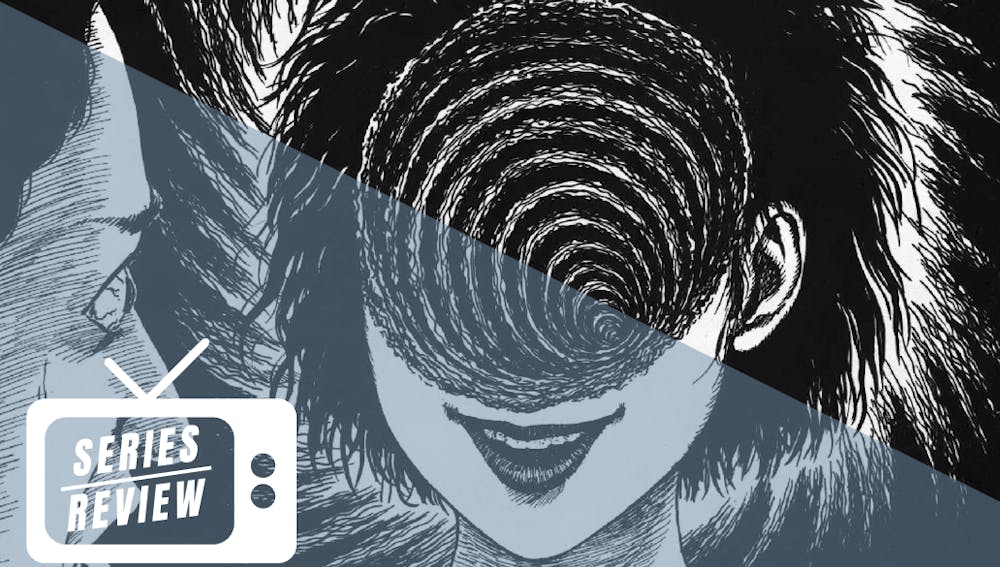The release of the animated adaptation of Junji Ito’s manga “Uzumaki” (1998) has been a long time coming — five years, to be exact. Between the onset of the COVID-19 pandemic and two delays related to the show’s development, “Uzumaki” (2024) perfectly represents perseverance and dedication in the animation industry. “Uzumaki” is directed by Hiroshi Nagahama, an experienced animation industry director and a self-declared admirer of Ito’s works. The first episode aired on Sept. 28 and concluded with its fourth and final episode on Oct. 19.
“Uzumaki” follows high school students Kirie Goshima (Uki Satake) and Shuichi Saito (Shin-ichiro Miki) as they try to survive a supernatural curse plaguing their town. The curse initially manifests innocuously through small whirlpools in a nearby river, but soon develops into an overwhelming abundance of spirals throughout the town. This sparks an obsessive mania among the townspeople, who begin to commit increasingly disturbing atrocities until the curse physically and mentally deforms them.
While the number of episodes is brief, the swift pacing of “Uzumaki” never lets the audience feel comfortable. By condensing the original manga’s 20 chapters into four 30-minute episodes, the series evokes the suspense that Ito builds in the simple action of turning a page. Even though this specific part of Ito’s style cannot be replicated in film, the quick pacing of the show creates a similar feeling by quickly moving between horrifying scenes to keep the audience on edge constantly.
While there are many adaptations of Ito’s iconically grotesque mangas, both live-action and animated, “Uzumaki” is unique in its purely monochromatic style. The stylistic choice demonstrates the dedication to the source material, making this adaptation the most faithful to Ito’s visual aesthetic. It is a key factor in establishing its grim atmosphere, particularly the darkening degree of shading in the characters and the background. The monochromatic gradient symbolizes the increasing madness the townspeople fall into, with their faces and bodies slowly darkening from pale white to a lifeless gray as they succumb to the curse.
A highlight of the series is its fluid animation, which also maintains Ito’s meticulous details. The fluidity of the animation adds a layer of realism, from the spontaneous curling of Goshima’s hair to the excruciating transformations of the townspeople into physical spirals. The series further shines in its stilled images, which allow the audience to take in the disturbing nature of the scene. These scenes display the dedication to the source material, where Ito utilizes a simple page turn to build suspense toward the grotesque and immaculately detailed image on the following page.
Even though the animation highlights the series, minor flaws are present in the characters’ basic movements. The animation of the characters’ mouths is particularly unpolished with little detail to distinguish the words in the dialogue. Furthermore, the walking and running animations are choppy at times, especially in the second episode. These flaws make the series seem like a strict adaptation of the manga, as they diminish the element of realism.
However, the stellar score still shines through to help establish the sinister Ito aesthetic throughout the series. “Uzumaki” is scored by Colin Stetson, who is notable in the horror genre for his work on films like “Hereditary” (2018) and “The Menu” (2022). The music creates the feeling of spiraling into madness, combining a rapid melody of string instruments with ethereal woodwind counter-melodies. The series utilizes the score to create an anxious tone by highlighting the disturbing moments with music that toes the line between distressing and mesmerizing.
The voice-acting works synergistically with the scoring, with each performance displaying a wide range of dark tones from despair to mania. One performance that elevates the series is Takashi Matsuyama as Toshio Saito, a character that catalyzes the ensuing madness of the series as the first victim of the curse. The change in Matsugama’s performance from genteel to menacing in a single episode is not only impressive but embodies the horror of “Uzumaki” as a whole.
Uzumaki is one of the best adaptations of Ito’s work, combining animation, voice acting and scoring to create a series that is not only a faithful adaptation of the manga but terrifying on its own merits.

Paige Hogan (27C) is from Dallas, Texas, and is majoring in Chemistry and Classical Civilization. Outside of the Wheel, she is on the executive boards of both her sorority, Delta Phi Epsilon, and the Emory Anime Club.In her free time, she enjoys hiking, listening to Arctic Monkeys, and marathoning all 10 Saw movies.








